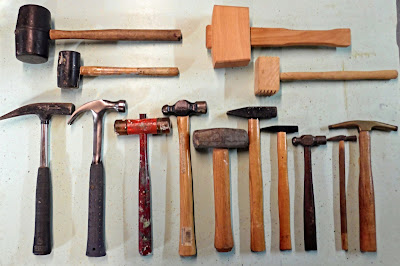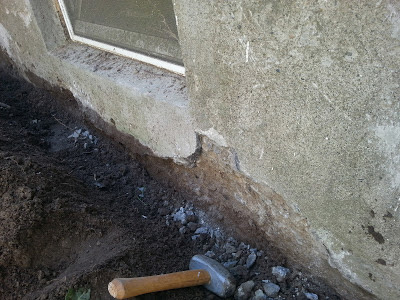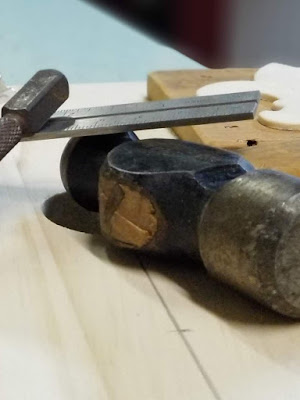A Study in Hammers
My Hammers and Mallets
I'm not aware of very many other dudes who sit around and write about their hammers. I mean, what guy sits around and waxes poetic about one of the simplest, oldest tools from antiquity? This guy (picture me pointing at myself with my thumbs while grinning a corny grin)!
Why write about hammers?
Mostly because I need some serious distraction from work. The pandemic still has its grip enough that there still aren't any projects going on. However, as the vaccines roll out, 2021 will hopefully shape up over the coming months. 'Til then, I find goofy, somewhat esoteric things to write about. Anyway, just a couple weeks ago I wrote about a few of my favorites of dad's tools including his Stanley SteelMaster hammer - the inspiration for my hammer. In that post, I also noted that I'd be writing about my hammers. Here's an old ad, I had to include it here, not just because of the hammer, but check out the young Yogi Berra!My hammer: Estwing E3-16C
I say dad's SteelMaster was my inspiration because it's what came to mind when I bought my hammer. I know that because I still remember that moment as clearly as if it were yesterday. Even before signing the mortgage for 173 in '97, it was clear the house was to be a lifelong project. Not that it was in bad shape, but because it was old and in need of updates, personalization and yes - some repairs. Straight away, my hammer would become, if not the, then close to, the first tool I would own.
Mind you, these were the days before the internet, at least for me, so I had no resource to research hammers. Yeah - read this blog for awhile and you'll see that I research just about every purchase I make - it's that ingrained frugality don't-ya-know. So all I could go by was feel and what dad had. As a matter of fact, as I stood there, I kept hoping to see the SteelMaster:
This model was a bit more expensive than the wood handled hammers, but it just felt so right. I think I paid about $20 for the hammer, which was a ton of money for me in those days. But, on walking out of the store, I had my hammer, an Estwing E3-16C. I had never heard of Estwing, all I really knew about tools was Craftsman, Black & Decker and Stanley. As it turns out though, Estwing has been making tools right here in America since 1923, and as late as 2020 the E3-16C was rated the best curved claw hammer on the market. Do I have great instincts or what? OR..what a stroke of luck! Probably luck.
My E3-16C has served me faithfully since the day I bought it! I think a hammer, much like a man's baseball glove, moulds itself to a man's hand. Pick up someone else's glove or hammer and you instantaneously know it ain't yours. I like that. Oh, by the way - the E3-16C means Estwing (no idea about the "3"), with 16C meaning 16 ounce curved claw. The curved claw makes nail pulling easier for amateur DIY-ers like yours truly.
The New York Times on the Estwing E3-16C:
October 9, 2018
After testing 21 hammers over the past four years, we recommend the Estwing E3-16C, a 16-ounce, curved claw, steel-handled tool that’s a favorite of carpenters everywhere and nearly perfect for any household job. The E3-16C has powerful heft without being uncomfortably large or heavy, its slightly squishy, tacky grip is among the easiest to hold and the least prone to vibration, and its striking face gives a clearer line of sight than tools with oversized heads.
My other hammers & Mallets
I've seen guys with literally dozens of hammers, I bet my dad even has at least a dozen-and-a-half. I'm not one of them. I'm a pragmatist, and only buy what I need instead of.....wait, what? Okay, I never actually counted my hammers:
I have more than I thought I did! But in reality I only bought maybe half of them, the others having been given to me, or bought a yard sales for pennies on the dollar. I don't know about you, but I fight the obsession within me to almost collect things I like. If I didn't fight it, I 100% know you would see so many other hammers, many in mint condition with labels in place - never having been used! Every time I'm out getting stuff for a project, I see some new improved version of some tool I have, and I stand there weighing my desire to get it, or just be happy with what I have because it's already better than I'll ever need. Nonetheless, as you can see I have a number of hammers - let's talk about some of them.
The Hammers
I've already told you more than anyone probably wants to know about my main hammer - my Estwing claw hammer. but there's a few others in the stable. There's an upholsterer's hammer with a magnet at one end to help start those small tacks. I got that one when I took the 3 or 4 week course on upholstering just for fun. Then I have the nylon, soft-faced hammer I often use as a persuader when nudging a board into place and don't want to mar the wood. And I have a couple ball peens and a Club hammer, the latter coming in handy any number of times - particularly when doing concrete work:
I also have a couple straight-peen hammers, one normal size, the other smaller. We'll talk about those a little more shortly. And, finally, I have a Shingle hammer. It's the one closest to the viewer in the picture below. It was given to me years ago, and I wasn't even sure what it's specific purpose was for a long time. I'll let the folks at Engineering Clicks explain: "The shingle hammer is a hybrid of various hammers and often referred to as a roofing hammer. It has a spike head and a square head and usually incorporates a small claw for pulling out nails. The spike is used to create nail holes in shingle and slate which will often shatter and break when using a traditional hammer. Once the hole is made the square head is used to push the nail through the slate/shingle and position it on a roof or similar structure."
To a man with a hammer, everything looks like a nail. - Mark Twain
The Mallets
Then there's the mallets. I don't use these that often but when I need them, they're nice to have around. To start, I have a large and a small rubber mallet. Two semi-interesting things: 1 - I use the small rubber mallet more often than the large, mostly because I use it to close paint can lids; 2 - I got the small mallet at the Dollar Store probably 20 years ago.
And finally, there's my wooden mallet. I often use it to knock wooden pieces together, when using a chisel. A wooden mallet won't mess up the striking end of the chisel as most metal hammers would. The best thing about this mallet is where I got it. To set the scene - you gotta understand Christmas with my family. It's always the most precious day of the year, but at the same time it's a flurry of activity with mixtures of small, meaningful traditions, the arrival and departure of people and their dogs, with a meal and gift giving, all over the space of a few hours. I love it, but if you can keep that in mind when you read the next sentence - I'd a appreciate it! I'm not sure who gave me my wooden mallet. It was Christmas 2018 and either my sister or her dude - Matt gave it to me. Dude. I like that better than boyfriend, but either way - one of them gave it to me and I love it! I used it the first time when I made the upstairs hallway accent table in March of 2019.
Impact Force of a Hammer
The hammer delivers an impact. Impulse equals the change of momentum. The hammer-head has mass m and had velocity v immediately before hitting the nail and comes to a stop. So its change of momentum is m*v. That is the impact. Impact is also force*time. (The time, t, is the fraction of a second during which the hammer-head came to a stop.)
Setting the 2 ways to calculate impulse equal to each other, F*t = m*delta_v
In our case, m*delta_v = m*v so F = m*v/t. You could say that the force comes from the original momentum changing to zero in such a short time. - Steve Johnson, North Dakota State University, 1966
My favorite hammers
Just like my favorite shirt or jeans, or my favorite hat, team or even baseball bat, I have my favorite hammers. Four of them to be precise. First up, the straight peen hammers. The large one I seem to use around the house for small repairs, and the small one drives those tiny nails into the wall for pictures, mirrors and so on. They seem just right for the tasks for which I grab them!
Next is my ball peen hammer. I have a smaller one that I don't use all to often, but my bigger one seems to be my go-to in the workshop. It's not as big as my claw hammer, but has enough heft to get the job done. Here it is from when I was making the radiator cover for the dining room back in '18:
And of course my favorite -my personal version of Thor's Mjölnir!
If you made it this far - thanks for indulging me, but after all - it's the little things - right? One last thing, this story wouldn't be complete without a quick mention of where I keep my hammers. They're stored in the workshop in a hammer rack built many years ago by Mr. Mosher, the original owner of 173. When I remodeled the basement, I made it a point to save that wall because of the hammer rack. It's just another one of those things I love about 173.
Stay safe out there!




















